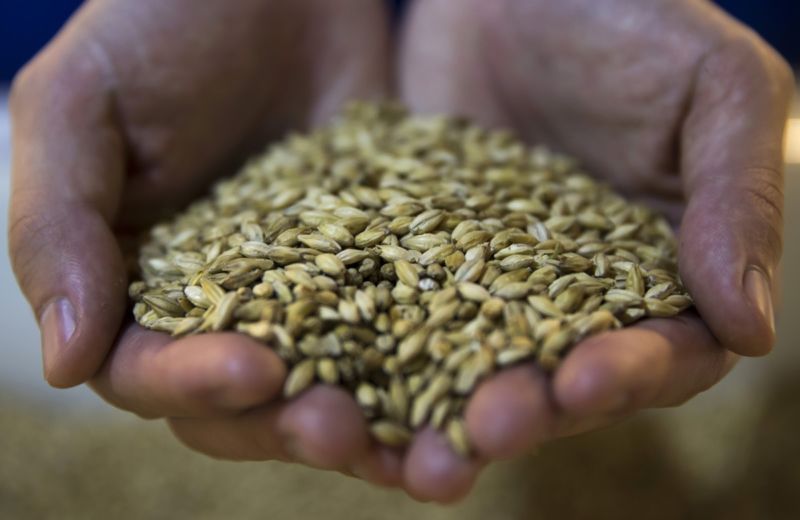
Over the last few years, archaeologists have learned a lot from ancient people’s dirty dishes. Microscopic residues clinging to the inside of potsherds contain chemical traces of ancient food and drink, which have revealed remarkable details of ancient people’s diets. But as much as we now know about when people started eating certain grains or fermenting milk to make cheese, we’re still not sure when people first started brewing beer. It’s hard to tell a container used for beer from one that was just storing plain old grain.
But by looking at the remains of ancient grains under a microscope, archaeologists can tell whether the grains had been malted—the first step in the process of brewing beer.
When grains start to germinate, or sprout, they release an enzyme called diastase, which converts the grain’s stockpile of starch into sugar. The whole point of malting is to make the grains release diastase but then stop the process before the starch gets turned into sugar. Once the brewer adds yeast to the malted grain, then, the diastase can produce more sugar to feed the yeast—and that produces carbon dioxide, alcohol, and a sweet taste. To make this happen, brewers soak grains in water so they start to germinate, then stop the process by air-drying the grains and heating them in an oven.
Austrian Academy of Science bioarchaeologist Andreas Heiss and his colleagues discovered that when barley germinates, the outer layer of the seed’s food store gets partially digested. That makes it easy to recognize malted barley under a microscope, because that outer layer looks unusually thin. The same is true of other grains in the grass family, like corn, rye, and wheat. By looking for that thinned outer wall under a microscope, archaeologists can tell whether ancient grains were malted, “even if the grains concerned are only preserved as pulverized and burnt crusts on pottery,” said Heiss.
It’s for science—really!
To test the idea, Heiss and his colleagues malted their own barley by charring it then examined the results under a scanning electron microscope. They compared their freshly malted barley with 5,000-year-old ancient samples from Egypt and Central Europe. The results looked very similar.
Both Egyptian sites in the study were known as ancient breweries. Archaeologists sampled charred clumps of wheat from ceramic vats at a predynastic political center called Hierakonpolis in Upper Egypt and at Tell el-Farkha, a sandy island in the eastern Nile Delta. They looked very similar to the charred barley from the archaeologists’ lab.
Heiss and his colleagues also studied grain residues left in containers from three lakeshore settlements in Germany and Switzerland, also dating back to around 5,000 years ago. None of these three sites offered any clear evidence that people brewed beer alongside the lakes, but under Heiss and his colleagues’ microscope, the grains had the same thinned outer walls as the barley they’d malted in the lab and the wheat from the ancient Egyptian breweries.
It’s the first evidence of malted drinks or food in Neolithic Europe. Heiss called that discovery “a small side effect” of the team’s research. “It took us quite a while to realize that, en passant, we had also provided the earliest evidence for malt-based food in central Europe.”
Drinking beer by the lake
But it’s still not proof of beer. “Malt-based food” can mean a lot of things. Brewing beer is only one reason people might malt grains like barley; throughout history, malted but unfermented grains have also been fed to infants being weaned, taken as tonics, or just eaten as a snack.
In addition, archaeologists don’t have a way to recognize the fermentation process itself using ancient grains. Although malting is a very common first step in the brewing process for beer and malted whiskeys, you don’t need malted grains in order to make alcohol. That means we may still be missing a lot of ancient booze.
For the Neolithic people who lived on the shores of Lake Constance in Germany and Lake Zurich in Switzerland, however, beer makes sense. The lumps of charred grain recovered from the site came from cooking vessels, which had shapes that don't seem very likely for cooking bread or storing sourdough. Other studies show that the lake waters around those settlements were teeming with intestinal parasites. “The inhabitants of these settlements definitely had good reason to produce and consume beer,” wrote Heiss and his colleagues.
Don’t we all.
PLOS ONE, 2020 DOI: 10.1371/journal.pone.0231696 (About DOIs).
reader comments
53